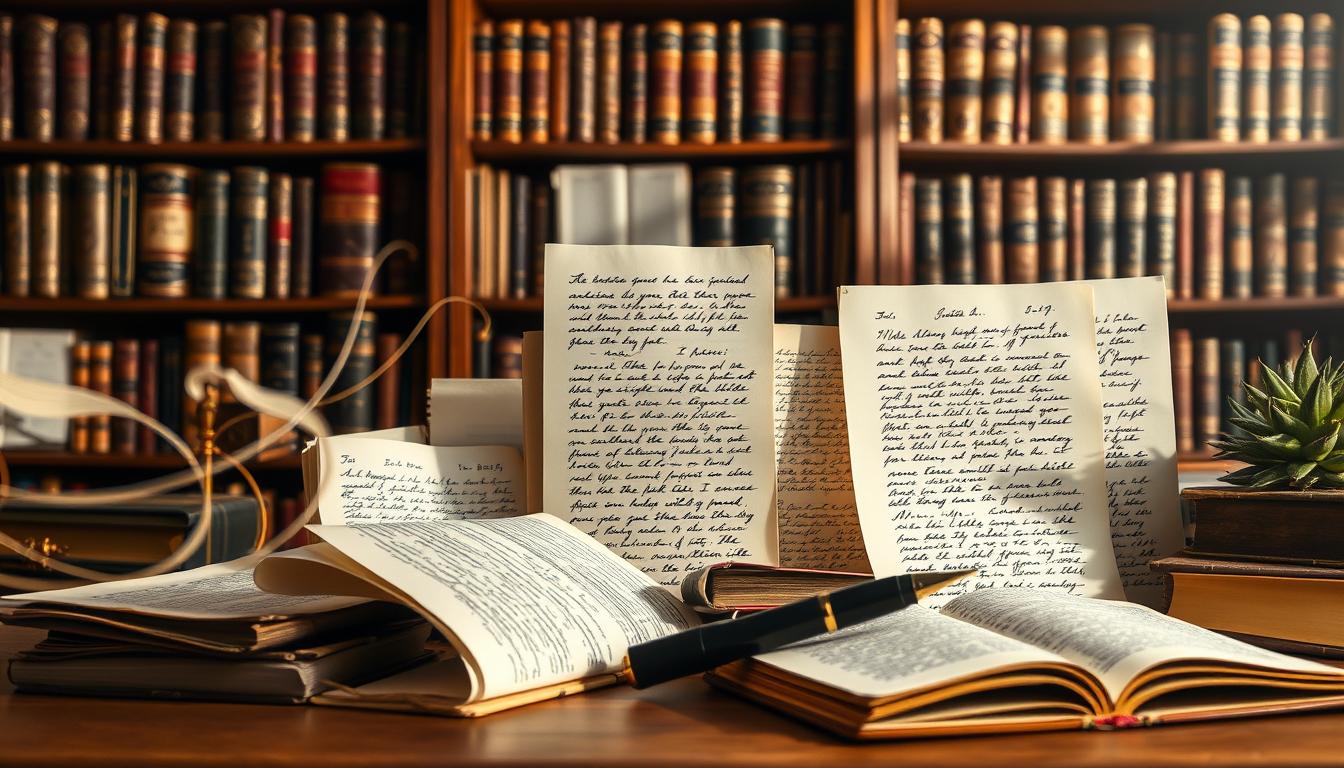Physical Address
304 North Cardinal St.
Dorchester Center, MA 02124
Physical Address
304 North Cardinal St.
Dorchester Center, MA 02124

What makes Ernest Hemingway’s prose instantly recognizable? How does Margaret Atwood’s voice differ from Ursula LeGuin’s? The answer lies in their distinctive styles—the invisible fingerprints that shape every sentence they craft. Like a painter’s brushstrokes or a musician’s rhythm, an author’s approach transforms ordinary words into unforgettable stories.
This guide explores how literary voices emerge through choices in vocabulary, sentence structure, and tone. It’s not just about grammar rules or proper punctuation. A writer’s style reflects their personality, experiences, and how they view the world—whether sparse and direct or lush with description.
You’ll learn how iconic authors developed their signatures over time. Unlike a formula, these techniques grow naturally through practice and experimentation. Think of style as the decorative details of a house: the color of the walls, the texture of the curtains, the way light filters through the windows.
Ever spotted a friend’s text in a group chat without seeing their name? That instant recognition comes from their unique patterns—the same way readers identify authors through repeated techniques. Like a favorite coffee order or signature laugh, these habits become trademarks over time.
Authors develop signature methods through trial and error. Some prefer short, punchy sentences. Others layer descriptions like paint on a canvas. These choices create a literary fingerprint that stays consistent across works while evolving naturally.
Consider how flexibility plays a role. A novelist might use poetic language for emotional scenes but switch to crisp dialogue in action sequences. This adaptability keeps readers engaged without losing the core voice they love.
| Element | Purpose | Example |
|---|---|---|
| Narrative Flow | Controls pacing | J.K. Rowling’s cliffhangers |
| Vocabulary Choice | Sets tone | Toni Morrison’s lyrical prose |
| Tone Shifts | Enhances emotion | David Sedaris’ humor-to-pathos pivots |
Recognizing these patterns does more than impress book clubs. It helps aspiring creators refine their own approach by analyzing what resonates. The magic lies in balancing consistency with creative growth—like updating a wardrobe while keeping your favorite jacket.
Have you ever read a sentence and immediately known who penned it? That instant recognition comes from an author’s style—the literary equivalent of a vocal cadence or handwriting flourish. Like architectural details on a home, these choices turn basic structures into personalized spaces.
An author’s approach emerges through countless decisions. Do they favor punchy verbs or languid descriptions? Metaphors that sting or similes that soothe? These textural choices form a creative fingerprint, distinct as a thumbprint on a page.
| Component | Role | Example |
|---|---|---|
| Word Choice | Sets emotional tone | J.D. Salinger’s casual teen dialogues |
| Sentence Rhythm | Controls reading pace | Ernest Hemingway’s brisk clauses |
| Thematic Focus | Reveals priorities | Octavia Butler’s exploration of power dynamics |
This fingerprint develops through practice and personality. Some authors craft theirs deliberately, while others discover it through trial. Either way, it’s never static—great voices evolve like gardens, pruning some elements while nurturing others.
Remember: Style answers “how” you express ideas, not “what” you’re creating. A technical manual and fantasy novel might share topics, but their execution separates textbooks from Tolkien.
Imagine a chef’s signature dish—its flavor comes from precise ingredient combinations. Similarly, an author’s writing style emerges through six core elements working in harmony. These components shape how ideas land, linger, or leap off the page.
Word choice acts as the foundation. Selecting “whisper” instead of “say” adds mystery. Picking “stumble” over “walk” implies struggle. Each decision tints sentences with specific moods and meanings.
Sentence structure controls rhythm. Short phrases create urgency. Long, winding ones build anticipation. This syntax determines whether readers feel breathless or contemplative.
Great authors prune unnecessary words. They know when five words pack more punch than fifteen. This economy keeps narratives sharp—like a sculptor chiseling marble.
Metaphors and symbolism add layers. A storm isn’t just weather—it becomes inner turmoil. These literary devices transform literal scenes into emotional landscapes.
Context steers choices. A sci-fi novel uses different language than a business report. Purpose and audience shape tone, whether playful or formal.
Finally, personal history leaves marks. An author raised near the ocean might use nautical metaphors. Current events or cultural heritage often seep into phrasing, creating stylistic fingerprints as unique as DNA.
Why do some authors’ voices echo in your mind long after you’ve closed their books? Let’s dissect how literary giants shape their writing style through deliberate choices. Take Mark Twain’s ode to cats: “Of all God’s creatures, there is only one that cannot be made slave of the leash.” His absolute statements and vivid comparisons create reverence while keeping language accessible.

T.S. Eliot takes a different path. By capitalizing “Cat” and “My” in his poetry, he bends grammar rules to show affection. This subtle rebellion proves style isn’t about following formulas—it’s about enhancing meaning through unexpected choices.
Contrast this with William S. Burroughs’ chaotic prose. Incomplete sentences and erratic punctuation mirror his raw emotional intensity. His approach shows how breaking conventions can amplify a message’s power when done purposefully.
Charles Bukowski demonstrates another extreme. His cat-themed poetry uses plain language without metaphors, delivering truth through stark simplicity. This proves impactful style doesn’t require decoration—sometimes directness cuts deepest.
These authors all explore the same subject yet achieve wildly different results. Their work confirms that how you express ideas matters as much as what you say. Whether through Twain’s eloquent comparisons or Bukowski’s bare-bones honesty, distinctive voices emerge from bold creative decisions.
Ever picked the wrong tool for a job? Using a hammer when you needed tweezers? That’s why understanding types of writing styles matters. Each approach serves specific goals, like specialized tools in a craftsman’s kit.
Narrative techniques build worlds through stories. Think J.K. Rowling’s character arcs or Stephen King’s suspense structures. These methods hook readers with plot progression and emotional journeys.
Descriptive approaches paint with words. Maya Angelou’s sensory details or J.R.R. Tolkien’s landscapes make readers taste, smell, and feel fictional realms. Vivid imagery becomes their superpower.
| Type | Purpose | Example |
|---|---|---|
| Persuasive | Change opinions | Malcolm Gladwell’s data-driven arguments |
| Expository | Explain concepts | Textbook explanations of photosynthesis |
| Narrative | Tell stories | Ernest Hemingway’s novellas |
| Descriptive | Create immersion | Mary Oliver’s nature poetry |
Persuasive methods wield logic and emotion. Political speeches blend statistics with heartfelt stories. Expository content focuses on clarity—think recipe steps or science articles.
Most great works mix different types. A memoir might blend narrative storytelling with persuasive reflections. The key lies in matching your dominant style to the project’s core purpose.
Try this: Next time you read, notice which style dominates. Is the author building worlds, convincing minds, or explaining processes? Recognizing these patterns sharpens your own creative toolkit.
Would Agatha Christie use the same voice for Poirot’s mysteries and a children’s fairy tale? Absolutely not. Writing style bends to its environment like bamboo in wind—flexible yet rooted in core principles. Authors mold their natural voice to fit each project’s unique demands, creating chameleon-like adaptations across genres.

Consider how a historical novel demands meticulous research and formal language, while middle-grade fiction thrives on playful dialogue. The same author might switch between complex metaphors for adults and straightforward explanations for young readers. It’s not about losing authenticity—it’s strategic shape-shifting.
Professional environments amplify this adaptability. Legal documents prioritize precision over poetry. Academic papers value evidence-based arguments rather than creative flourishes. These contexts require writers to temporarily shelve personal preferences for industry standards.
Successful creators balance their signature style with audience expectations. Mystery novels need red herrings and cliffhangers. Tech manuals demand step-by-step clarity. As you develop a consistent writing style across, remember: great voices adjust their volume and tempo without changing their fundamental tone.
Next time you write, ask: Who needs this information? What emotional response matters most? Your answers will guide your stylistic toolkit choices better than any rigid formula. After all, even Shakespeare switched sonnets for soliloquies when the scene demanded it.
Ever wondered why certain phrases stick in your mind like gum on a shoe? That’s literary devices at work—the secret sauce authors use to turn bland sentences into unforgettable experiences. These techniques shape how we interpret stories, transforming basic language into emotional rollercoasters.
While metaphors and similes get most attention, master writers tap into 30+ techniques. Hyperbole stretches truth for comic effect. Synecdoche lets a “hand” represent labor. Onomatopoeia makes sentences crackle with sound. Each device becomes a brushstroke in the author’s stylistic portrait.
| Device | Function | Example |
|---|---|---|
| Metaphor | Creates imagery | “Time is a thief” |
| Paranomasia | Adds wordplay | “A bicycle can’t stand alone—it’s two-tired” |
| Anaphora | Builds rhythm | Martin Luther King’s “I Have a Dream” repetitions |
Great authors layer these tools. Toni Morrison might weave symbolism through entire chapters. Neil Gaiman could drop a single perfect simile that haunts readers for weeks. The magic happens when devices feel natural—not forced decorations.
Your favorite writer’s style likely hinges on their go-to techniques. J.D. Salinger leaned on colloquial dialogue. Flannery O’Connor used shocking irony. These choices become their creative fingerprints—unique as snowflakes.
Want to sharpen your language skills? Analyze how devices appear in your favorite book. Notice when they make you laugh, gasp, or underline sentences. That’s how abstract literary devices become concrete emotional bridges between author and audience.
Have you ever noticed how two authors can paint the same picture with entirely different brushes? John le Carré’s “Perhaps you have forgotten…” cuts like a knife—short, direct sentences mirroring modern society’s collective amnesia. His conversational tone pulls readers into urgent moral questions.
Contrast this with Haruki Murakami’s approach in 1Q84. His layered prose dissects memory through philosophical musings. Where le Carré accuses, Murakami observes—longer sentences winding through psychological landscapes.
Both examples explore how power shapes remembrance. Yet their styles create distinct experiences. Le Carré’s clipped dialogue feels like a courtroom cross-examination. Murakami’s introspective narration resembles midnight confessions.
These different writing approaches prove how you tell a story matters as much as its content. Aspiring authors can learn from such contrasts—study what makes each voice resonate with specific readers. Try rewriting famous passages in alternative styles to discover your own creative fingerprints.